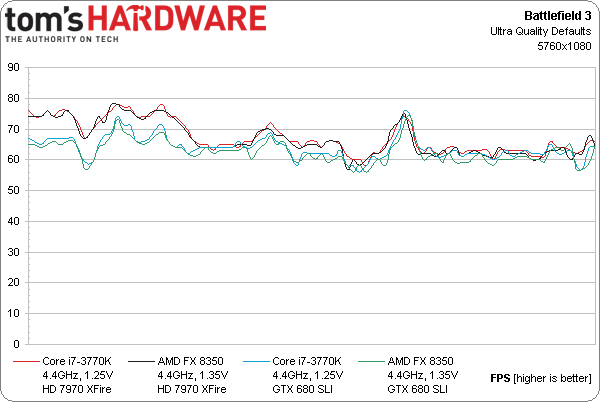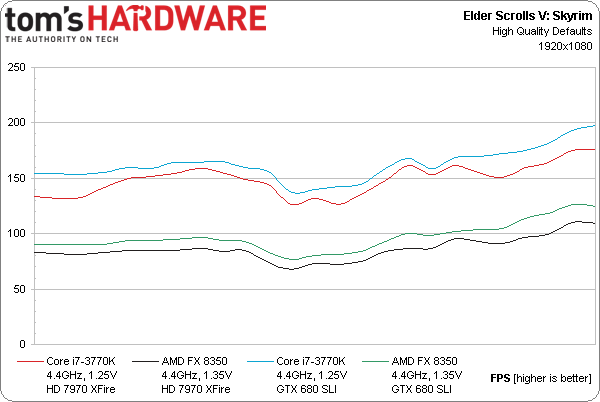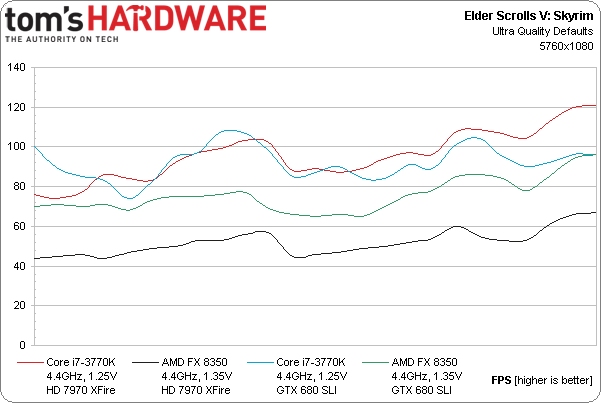CrossFire Versus SLI Scaling: Does AMD's FX Actually Favor GeForce?
We've heard it said before that AMD's GPUs are more platform-dependent than Nvidia's. So, what happens when you drop a Radeon and a GeForce into an FX-8350-based system? Does AMD's CPU get in the way of its GPU running as well as it possibly could?
Frame Rate-Over-Time Analysis
Our first article included a frame rate-over-time analysis intended to identify problematic sequences in our testing. Regardless of whether you're using one card or multiple GPUs, dramatic slow-downs interrupt game play. Unfortunately, although Nvidia enabled Don (up in Canada) and Chris (down in Southern California) with its FCAT tools, I'm only able to use the Fraps-based testing I ran previously. We know from our comparisons in Challenging FPS: Testing SLI And CrossFire Using Video Capture that Fraps isn't able to accurately capture the dropped and runt frames that might plague one graphics solution but not the other. However, we are at least able to track when each combination of cards drops to levels we deem unplayable.
Our least-demanding Battlefield 3 settings should reveal CPU bottlenecks, and indeed we see that three out of four multi-GPU configurations turn in similar results. Only Intel's Core i7 is powerful enough to butt up against the game’s 200 FPS cap, and only when it’s paired with two GeForce GTX 680s in SLI.
Our most taxing settings should demonstrate GPU limits. Unfortunately, those limits appear fairly consistent for all four dual-GPU configurations. At least the test runs smoothly, staying well above 50 FPS throughout its duration.
An attempt to demonstrate CPU-bound conditions in Skyrim is somewhat successful, with noticeable separation between the Intel and AMD CPU results. Both processors favor SLI over CrossFire in this title.
And now for our most taxing detail settings in Skyrim, where graphics performance matters most. Two Radeon HD 7970s in CrossFire beat the GeForce GTX 680s in SLI on the Intel-based system, while the reverse holds true for AMD's FX-8350. Doh!
Get Tom's Hardware's best news and in-depth reviews, straight to your inbox.
Current page: Frame Rate-Over-Time Analysis
Prev Page Results: Metro 2033 Next Page Results: 3DMark 11-
Crashman BigMack70This article was a good laugh... I sincerely hope nobody is throwing $800+ worth of graphics muscle onto an FX series CPU.I think AMD is just trolling gamers with their CPUs. Although they're definitely catching up to Intel while Intel just sorta sits there and doesn't do anything after declaring ultimate victory with Sandy Bridge.The great thing about AMD is that its chipsets have a lot of PCIe lanes. That should make them great for multi-way graphics. The problem is, the more cards you add the worse the CPU looks. I can see someone doing 3-way SLI on a new 990FX board if they already had a few older/slower cards laying around.Arfisy Perdanawhat a pity for amd processor. So terribleNot terrible, AMD charges appropriately less for its slower CPU. It's no big deal, unless you're trying to push some high-end AMD graphics cards.Reply
Nobody remembers that at the time AMD bought ATI, they already had a business partnership with Nvidia on the co-marketing of 650A chipsets (AMD Business Platform) Also at the time AMD bought ATI, ATI already had a business partnership with Intel to develop the RD600 as a replacement for the 975X. AMD's purchase left both Nvidia and Intel stranded, as it took Intel more than a year to develop a replacement for the abandoned RD600.
-
Crashman BigMack70Meh... they're PCI-e 2.0 lanes so they need twice as many to equal the PCI-e 3.0 lanes on Z77Depends on the cards you're using. 3-way at x8/x8/x4? Tom's Hardware did an article on how bad PCIe 2.0 x4 performed, so if you're carrying over a set of PCIe 2.0 cards from a previous system, well, I refer to the same comment that you referenced.Reply -
Thanks for the article it was great.Reply
Amd is actually doing fine with their products especially with their GPUs.
Why so much hate on their CPUs i will never understand.They are cheaper aren't they?
-
CaptainTom I'm going to be honest, this article didn't prove anything for these reasons:Reply
-The i7 is stronger so of course it scaled better.
-The 7970 is on average a stronger card than the 680, so of course it needs a little extra CPU power.
-The differences overall were very little anyways besides the obvious things like Skyrim preferring Intel. -
smeezekitty CaptainTomI'm going to be honest, this article didn't prove anything for these reasons:-The i7 is stronger so of course it scaled better.-The 7970 is on average a stronger card than the 680, so of course it needs a little extra CPU power.-The differences overall were very little anyways besides the obvious things like Skyrim preferring Intel.You hit the nail right on the head.Reply -
ohyouknow CaptainTomI'm going to be honest, this article didn't prove anything for these reasons:-The i7 is stronger so of course it scaled better.-The 7970 is on average a stronger card than the 680, so of course it needs a little extra CPU power.-The differences overall were very little anyways besides the obvious things like Skyrim preferring Intel.Reply
Truth. Didn't really see anything other than the same games that show the FX falling behind did the same thing in this test as it would with anything involving Skyrim and so forth. -
billcat479 I wish I could have seen a lets say better test. I'm not great at knowing which games to pick and one thing I would have liked to see is games that are able to use more than one core of the cpu.Reply
I know when the AMD came out with the new FX it's single threading was still not up to intel's standards but in many of the tests that used more core's the AMD could actually keep up with Intel's cpus. Not as good all the time but it's very very easy to make these AMD cpu's look bad, just run a single threaded and/or older game at them and presto.
I would have liked to see how the video card would play into this, if AMD's running more optimized software would it's crossfire come out better as well as it's overall effect in games that make use of this.
I mean how long have we had more than one cpu core running now?
And I know it's taken the software people to come up to speed but the game board is changing and they are starting more and more to use more than one core so do you think this would be important to check out as well. And just maybe see some new data from how the AMD can use video cards if it's running software it was really designed for?
We can play this Intel single thread line till hell freezes over and we all know there will not be any surprises as long as we do.
And we also have seen a shift if low cost game setups start to favor AMD's older cpus because there is more software that can run on more core's? So lets start to even out the playing field a bit here ok?




